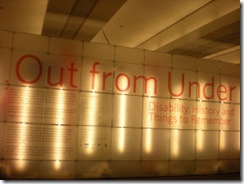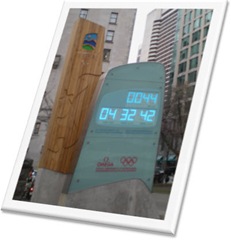Responsible Blogging Afoot (or How I Advocate for Myself)
Several weeks ago I shared what happened when my foot met the wall’s metal corner strip; the outcome wasn’t pretty for either one. I also shared my trip to the Emergency Room and how my husband was told to leave my side because there was not enough room for two wheelchairs, in spite of explaining I needed him for communication purposes.
Thanks to a concerned reader, my post was forwarded to the Emergency & Trauma’s Program Quality Improvement Assistant for the Fraser Health Authority. An investigation was launched and I was informed that I could expect a response within thirty business days. I made a note on my calendar.
Last Tuesday – thirty business days plus a few – I emailed the Program Quality Improvement Assistant to ask when I may hear the outcome of the investigation.
A short while later I received a call from the Emergency Department Manager. Thankfully Darrell was home to act as interpreter: the telephone isn’t my most effective means of communication. The manager apologized for her tardy response. She continued by explaining the ER is experiencing an extreme lack of space and that she is hoping the $700 million expansion will have more space. Space for patients in wheelchairs would be nice. She further explained that Darrell being told to leave should not have happened and she has discussed this with her staff.
When I asked what I should do if the situation should happen again, she offered her direct number, which, although kind, I wasn’t sure that would be practical in an emergency situation. She then said I could ask to speak to the nurse-in-charge – a much more direct and practical solution in my mind. I thanked her for her time.
in going through this process, I have come to two realizations:
- Initially, I felt that launching an investigation into a relatively minor incident (compared to the life and death situations the ER faces) was overkill. But I now have the words “ask for the nurse-in-charge†(words that hadn’t previously occurred to me) for next time, and next time might be more serious than an extremely sore foot.
- Sharing an upsetting experience in a blog post may be therapeutic, cathartic, and may garner a few comments or tweets. But readers might also be moved to take action based on words I have written. As a blogger, I feel I have a responsibility to not post a rant and leave it at that. I believe I need to write a follow-up post, much like this one, sharing what actions I took, what insights I gained, what lessons I learned, or something so that readers can also gain or benefit from it. I consider this responsible blogging.
In this specific situation, I can appreciate that the initial incident – Darrell being told to leave – was more a concern for keeping pathways clear should a stretcher need through urgently than a blatant denial of my access to communication; although the end result was still being denied access. I get that space is an issue; one symptom of our broken health care system. I did feel it necessary to allow the hospital staff the full thirty days for their investigation process without a barrage of emails on my part. I appreciate more urgent, more life threatening issues likely came up, delaying their response back to me. I also felt it necessary to remain polite and understanding. At no point was there a reason for being rude or for escalating action, which may have resulted in me being blacklisted at the hospital, interfering with receiving appropriate care in the future. In the end, patience and understanding are key when advocating.
If you enjoyed this post, consider buying me a chai tea latte. Thanks kindly.

 Presented as part of the
Presented as part of the 

 Subscribe via RSS
Subscribe via RSS



